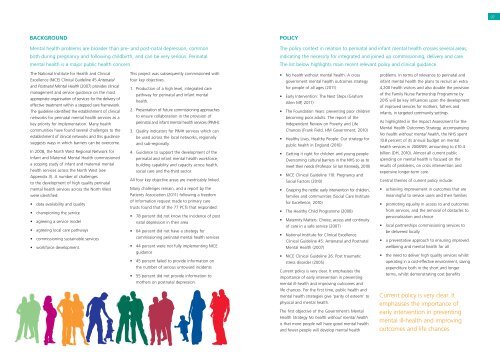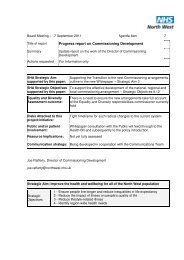Improving outcomes, ensuring quality: a guide for - NHS North West
Improving outcomes, ensuring quality: a guide for - NHS North West
Improving outcomes, ensuring quality: a guide for - NHS North West
You also want an ePaper? Increase the reach of your titles
YUMPU automatically turns print PDFs into web optimized ePapers that Google loves.
07BACKGROUNDMental health problems are broader than pre- and post-natal depression, commonboth during pregnancy and following childbirth, and can be very serious. Perinatalmental health is a major public health concern.POLICYThe policy context in relation to perinatal and infant mental health crosses several areas,indicating the necessity <strong>for</strong> integrated and joined up commissioning, delivery and care.The list below highlights main recent relevant policy and clinical guidance.The National Institute <strong>for</strong> Health and ClinicalExcellence (NICE) Clinical Guideline 45 Antenataland Postnatal Mental Health (2007) provides clinicalmanagement and service guidance on the mostappropriate organisation of services <strong>for</strong> the delivery ofeffective treatment within a stepped care framework.The <strong>guide</strong>line identified the establishment of clinicalnetworks <strong>for</strong> perinatal mental health services as akey priority <strong>for</strong> implementation. Many healthcommunities have found several challenges to theestablishment of clinical networks and this guidancesuggests ways in which barriers can be overcome.In 2008, the <strong>North</strong> <strong>West</strong> Regional Network <strong>for</strong>Infant and Maternal Mental Health commissioneda scoping study of infant and maternal mentalhealth services across the <strong>North</strong> <strong>West</strong> (seeAppendix 3). A number of challengesto the development of high <strong>quality</strong> perinatalmental health services across the <strong>North</strong> <strong>West</strong>were identified:• data availability and <strong>quality</strong>• championing the service• agreeing a service model• agreeing local care pathways• commissioning sustainable services• work<strong>for</strong>ce development.This project was subsequently commissioned withfour key objectives.1. Production of a high level, integrated carepathway <strong>for</strong> perinatal and infant mentalhealth.2. Presentation of future commissioning approachesto ensure collaboration in the provision ofperinatal and infant mental health services (PIMH).3. Quality indicators <strong>for</strong> PIMH services which canbe used across the local networks, regionallyand sub-regionally.4. Guidance to support the development of theperinatal and infant mental health work<strong>for</strong>ce,building capability and capacity across health,social care and the third sector.All four key objective areas are inextricably linked.Many challenges remain, and a report by thePatients Association (2011) following a freedomof in<strong>for</strong>mation request made to primary caretrusts found that of the 77 PCTs that responded:• 78 percent did not know the incidence of postnatal depression in their area• 64 percent did not have a strategy <strong>for</strong>commissioning perinatal mental health services• 44 percent were not fully implementing NICEguidance• 45 percent failed to provide in<strong>for</strong>mation onthe number of serious untoward incidents• 55 percent did not provide in<strong>for</strong>mation tomothers on postnatal depression.• No health without mental health. A crossgovernment mental health <strong>outcomes</strong> strategy<strong>for</strong> people of all ages (2011)• Early Intervention: The Next Steps (GrahamAllen MP, 2011)• The Foundation Years: preventing poor childrenbecoming poor adults. The report of theIndependent Review on Poverty and LifeChances (Frank Field, HM Government, 2010)• Healthy Lives, Healthy People: Our strategy <strong>for</strong>public health in England (2010)• Getting it right <strong>for</strong> children and young people:Overcoming cultural barriers in the <strong>NHS</strong> so as tomeet their needs (Professor Sir Ian Kennedy, 2010)• NICE Clinical Guideline 110: Pregnancy andSocial Factors (2010)• Grasping the nettle: early intervention <strong>for</strong> children,families and communities (Social Care Institute<strong>for</strong> Excellence, 2010)• The Healthy Child Programme (2008)• Maternity Matters: Choice, access and continuityof care in a safe service (2007)• National Institute <strong>for</strong> Clinical ExcellenceClinical Guideline 45: Antenatal and PostnatalMental Health (2007)• NICE Clinical Guideline 26: Post traumaticstress disorder (2005)Current policy is very clear. It emphasises theimportance of early intervention in preventingmental ill-health and improving <strong>outcomes</strong> andproblems. In terms of relevance to perinatal andinfant mental health the plans to recruit an extra4,200 health visitors and also double the provisionof the Family Nurse Partnership Programme by2015 will be key influences upon the developmentof improved services <strong>for</strong> mothers, fathers andinfants, in targeted community settings.As highlighted in the Impact Assessment <strong>for</strong> theMental Health Outcomes Strategy, accompanyingNo health without mental health, the <strong>NHS</strong> spent10.8 percent of its annual budget on mentalhealth services in 2008/09, amounting to £10.4billion (DH, 2010). Almost all current publicspending on mental health is focused on theresults of problems, on crisis intervention andexpensive longer-term care.Central themes of current policy include:• achieving improvement in <strong>outcomes</strong> that aremeaningful to service users and their families• promoting e<strong>quality</strong> in access to and <strong>outcomes</strong>from services, and the removal of obstacles topersonalisation and choice• local partnerships commissioning services tobe delivered locally• a preventative approach to <strong>ensuring</strong> improvedwellbeing and mental health <strong>for</strong> all• the need to deliver high <strong>quality</strong> services whilstoperating in a cost-effective environment, savingexpenditure both in the short and longerterms, whilst demonstrating cost benefitslife chances. For the first time, public health andmental health strategies give ‘parity of esteem’ tophysical and mental health.The first objective of the Government’s MentalHealth Strategy No health without mental healthis that more people will have good mental healthand fewer people will develop mental healthCurrent policy is very clear. Itemphasises the importance ofearly intervention in preventingmental ill-health and improving<strong>outcomes</strong> and life chances.
















